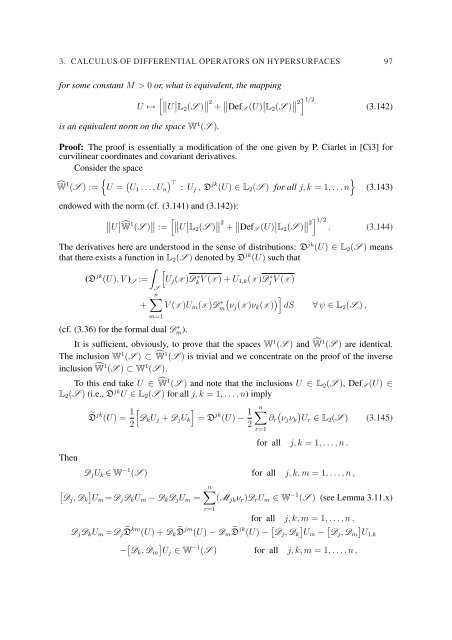EQUATIONS OF ELASTIC HYPERSURFACES
EQUATIONS OF ELASTIC HYPERSURFACES
EQUATIONS OF ELASTIC HYPERSURFACES
Create successful ePaper yourself
Turn your PDF publications into a flip-book with our unique Google optimized e-Paper software.
3. CALCULUS <strong>OF</strong> DIFFERENTIAL OPERATORS ON <strong>HYPERSURFACES</strong> 97<br />
for some constant M > 0 or, what is equivalent, the mapping<br />
[ ∥∥U ∣<br />
U ↦→ ∣L2 (S ) ∥ 2 + ∥ DefS (U) ∣ L2 (S ) ∥ 2] 1/2<br />
(3.142)<br />
is an equivalent norm on the space W 1 (S ).<br />
Proof: The proof is essentially a modification of the one given by P. Ciarlet in [Ci3] for<br />
curvilinear coordinates and covariant derivatives.<br />
Consider the space<br />
{<br />
Ŵ 1 (S ) := U = ( ) }<br />
⊤<br />
U 1 . . . , U n : Uj , D jk (U) ∈ L 2 (S ) for all j, k = 1, . . . n (3.143)<br />
endowed with the norm (cf. (3.141) and (3.142)):<br />
∥ U<br />
∣ ∣Ŵ 1 (S ) ∥ ∥ :=<br />
[ ∥∥U ∣ ∣L2 (S ) ∥ ∥ 2 + ∥ ∥ DefS (U) ∣ ∣ L2 (S ) ∥ ∥ 2] 1/2<br />
. (3.144)<br />
The derivatives here are understood in the sense of distributions: D jk (U) ∈ L 2 (S ) means<br />
that there exists a function in L 2 (S ) denoted by D jk (U) such that<br />
∫ [<br />
(D jk (U), V ) S := U j (X )Dk ∗V (X ) + U 1,k(X )Dj ∗V (X )<br />
+<br />
S<br />
n∑<br />
V (X )U m (X )Dm( ∗ νj (X )ν k (X ) )] dS ∀ ψ ∈ L 2 (S ) ,<br />
m=1<br />
(cf. (3.36) for the formal dual D ∗ m).<br />
It is sufficient, obviously, to prove that the spaces W 1 (S ) and Ŵ1 (S ) are identical.<br />
The inclusion W 1 (S ) ⊂ Ŵ1 (S ) is trivial and we concentrate on the proof of the inverse<br />
inclusion Ŵ1 (S ) ⊂ W 1 (S ).<br />
To this end take U ∈ Ŵ1 (S ) and note that the inclusions U ∈ L 2 (S ), Def S (U) ∈<br />
L 2 (S ) (i.e., D jk U ∈ L 2 (S ) for all j, k = 1, . . . , n) imply<br />
˜D jk (U) = 1 ]<br />
[D k U j + D j U k = D jk (U) − 1 n∑ ( )<br />
∂ r νj ν k Ur ∈ L 2 (S ) (3.145)<br />
2<br />
2<br />
Then<br />
r=1<br />
for all j, k = 1, . . . , n .<br />
D j U k ∈ W −1 (S ) for all j, k, m = 1, . . . , n ,<br />
[<br />
Dj , D k<br />
]<br />
Um =D j D k U m − D k D j U m =<br />
n∑<br />
(M jk ν r )D r U m ∈ W −1 (S ) (see Lemma 3.11.x)<br />
r=1<br />
for all j, k, m = 1, . . . , n ,<br />
D j D k U m =D j ˜Dkm (U) + D k ˜Djm (U) − D m ˜Djk (U) − [ D j , D k<br />
]<br />
Um − [ D j , D m<br />
]<br />
U1,k<br />
− [ D k , D m<br />
]<br />
Uj ∈ W −1 (S ) for all j, k, m = 1, . . . , n ,

















